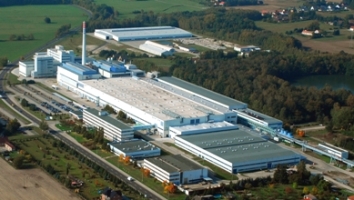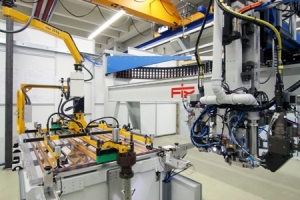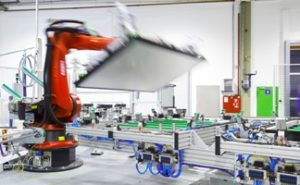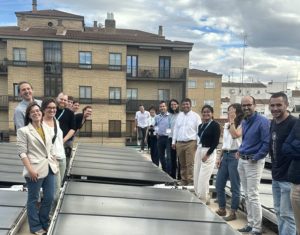Textured Solar Glass Made in Germany
August 28, 2009
 Specialised in manufacturing solar glass: The new factory of Interfloat Corporation, near Berlin, is producing textured glass only, for manufacturers of solar thermal collectors, as well as photovoltaic modules.
Specialised in manufacturing solar glass: The new factory of Interfloat Corporation, near Berlin, is producing textured glass only, for manufacturers of solar thermal collectors, as well as photovoltaic modules.
Photo: GMB Glasmanufaktur Brandenburg
Interfloat Corporation is the first independent glass producer specialized in solar glass manufacturing. In 2008, the Liechtenstein-based company established a glass production site, which is run by its subsidiary GMB Glasmanufaktur Brandenburg, in the German town of Tschernitz. All year round, the Interfloat factory is producing solar textured glass only, a big difference to major glass suppliers, such as Pilkington (UK/Japan), Asahi Glass Company / AGC (Japan) and Saint-Gobain (France). These suppliers produce their solar glass in batches together with ordinary glass on the same machines.
“We optimized production, starting with where we get the sand from, over how to manage process purity, up to energy consumption in the factory, in order to offer an environmental friendly product to the solar industry,” Ulrich Frei, Interfloat’s managing director, explains.
GMB has a daily capacity of 300 tons of textured solar glass (approx. 30,000 m2/day) of which 25 % is shipped to collector manufacturers and 75 % to PV module factories. The glass is produced by means of rollers, pressing the desired surface texture into the hot raw glass. Solar transmission at a thickness of 3.2 mm is 91.8 % ± 0.5 %. “But solar transmission is not the only factor determining solar glass performance,” Interfloat remarks on its website. “Another important factor is the additional reflection loss on the surface, whenever the sun is not perpendicular to the glass surface.” The manufacturer will therefore try to minimize reflection losses, depending on how the glass is used in further processing. And SILK and ASTRA are both textured glass types with low reflection losses, optimised for solar thermal collectors.
At present, Interfloat does not offer an anti-reflective (AR) coating, but plans to add one to its product range by the end of the year. According to Frei, this will become an integral system feature of PV modules. The situation for solar thermal collectors tends to be more complex. Applied to special uses, such as solar cooling, AR coating helps to shift efficiency to the needed range. In this case, the solar collector must be designed very carefully. The coating, however, is no first priority in manufacturing normal collectors for standard uses (solar water heating). In addition, there is a good chance in many standard collector designs that the inner coating is loosing its effect, because of the damage done by outgasing products of inner components like insulation, EPDM rubber or glue.
Interfloat Corporation is supplying markets in Europe, the US and the Far East. Considering the CO2 balance of the end product, the company focuses primarily on the European market.
More information:
http://www.interfloat.com
Uli Frei will be one of the speakers at the international conference SMEThermal – Solar Thermal Materials, Equipment and Technology Conference hold in Berlin at the 4th of March 2010. Further information:
http://www.solarpraxis.de/index.php?id=1642


